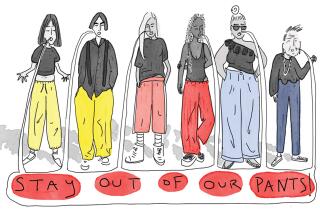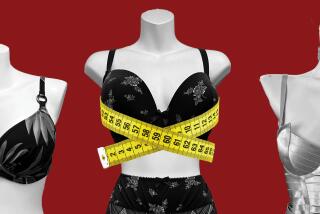BODY WATCH : How to Keep the Bounce Out of Sports
In the old days, so the story goes, women wore two bras at once to prevent “breast bounce” while exercising. That, of course, was before the birth of the first sports bra. In 1978, two women runners sewed together two jock straps, creating the prototype Jogbra.
Since then, an explosion of options has joined the lineup. At least 10 companies now offer sports bras, industry experts estimate, with models ranging from plain-Jane discount store models for under 10 bucks to flowered underwire models costing $35 and up. Women spend about $30 million a year on sports bras, according to industry estimates.
*
The Candidates: Well-endowed women tend to have more discomfort than smaller-breasted women if exercising without a supportive bra. Still, physicians and exercise experts encourage every woman to wear a well-fitting, supportive bra, especially if they engage in such “high-bounce” activities as running, volleyball, cheerleading, basketball and horseback riding.
“It’s always good to wear a sports bra, even if you’re not doing high-impact activities,” says Rudy Hayek, a Tarzana exercise physiologist, “because it helps stabilize the torso.”
“The structures that support the breast are relatively weak,” says LaJean Lawson, a Portland, Ore., exercise scientist and former professor who has researched sports bras for about a decade. When stretched during exercise, the breast skin recovers, whether a woman wears a bra or not, Lawson says. But supporting the breasts firmly but gently while exercising is definitely the better idea, she and other experts say.
*
The Options: The plain white sports bra has lots of company these days. Jogbra, for instance, still offers traditional white styles along with more fashionable floral prints and hot colors such as French blue and jade.
For fuller-breasted women, there’s the New Sports Bra, an underwire model created by Kimberly Mattson, a Los Angeles accountant and fitness enthusiast who never liked the choice of sports bras when she went shopping. The bras, she says, are “non-compressive,” meaning they support without flattening. They’re available in black, white, florals and other colors.
*
Fitting Tips: Finding a supportive sports bra that’s also comfortable is the main goal, say exercise experts. “What’s best depends on the size of the woman and the sport,” Lawson says. While smaller-busted women (A and B cups) might not need maximal support, they should still look for fabrics with good ability to draw away moisture, Lawson says, and straps that don’t bind.
“If you’re an A or B size, you can probably get by spending only $12 or $15 for a sports bra,” says Lawson, who also consults for a sports bra manufacturer. But those with C cup or above probably will need to spend more to get maximal support.
“Some sports bras are quite effective, some are not,” says Dr. Gerry Smith, assistant professor of exercise science at Oregon State University, Corvallis, who has also researched sports bras. “The materials are a good clue. If it is just elastic, probably it is not good enough support.”
“A sports bra really needs to fit well around the rib cage,” adds Anne Boschma, who has researched the fit and function of sports bras while a graduate student researcher at Oregon State.
*
Linking Bra with Sport: Select a bra suited to your activity, experts suggest. Jogbra, for instance, advises consumers to pick styles labeled “Low MCR”--for motion control requirements--if they plan to engage in low-impact sports such as cross-country skiing, walking or weight training. They should pick styles labeled “Medium MCR” for rowing, fast walking or step aerobics, and those labeled “High MCR” for soccer, running, martial arts and other high-impact activities.
“Do a few movements (similar to your workout) and see if it is comfortable,” Mattson says. When shopping, wear whatever you normally wear working out so you can see how the bra fits underneath it, she adds.
*
Maintenance Clues: When a sports bra starts to stretch in areas that didn’t used to, it’s probably time for a trade-in.
Before buying again, remeasure, Mattson suggests, especially if your weight has changed. Even if weight remains stable, take measurements every year or so.






